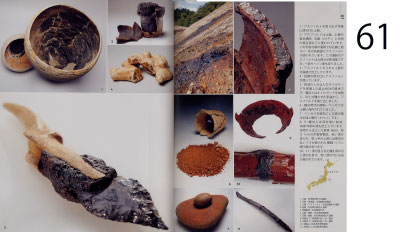1 (top left, p. 60):
Pots that were used to extract asphalt.
2 (bottom, p. 60):
Asphalt was used as adhesion to repair potteries and clay figurines, and to attach stone arrowheads to shafts. In this site at the northern tip of the Japanese Archipelago, asphalt was used for bonding stone arrowheads to the tips of fish spears. Most of the asphalt used in this site was from Niigata prefecture, but part of it was from Sakhalin.
3 (right top, p. 60):
A pottery filled with asphalt was excavated from a site in Hokkaido.
4 (right, second from top, p. 60):
There are traces of asphalt on the fractured parts of stone figurines.
5 (left top, p. 61):
The site of a mining company that dug oil sand infiltrated with crude oil. The Jomon people heated oil sand and separated the oil from the sand, and thus extracted asphalt from crude oil.
6 (middle left, p. 61):
Red-ocher rouge, the pigment of the Jomon period, was preserved in a deep pot.
7 (bottom left, p. 61):
A grinding slab and a grindstone that have traces of powdered red-ocher rouge.
8 (top right, p. 61), 9 (second top right, p. 61):
The Jomon people started to use lacquer at early periods. There is an excavated lacquered object dated to 9,000 years ago.
A wooden bowl 46 cm in diameter and 1 cm in thickness was excavated from a swamp. It is painted with red lacquer, and the upper part of the handle has traces of mother-of-pearl work where round caps of spiral shells were put.
10 (right, second from bottom, p. 61), 11 (right bottom, p. 61):
It appears to be a bow used for rituals, painted with red lacquer. A string was wrapped around on this red lacquered bow.
